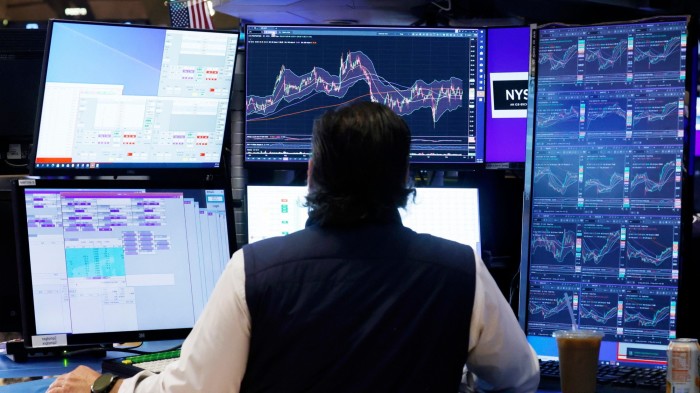Unlock the Editor’s Digest for free
Roula Khalaf, Editor of the FT, selects her favourite stories in this weekly newsletter.
The first inklings of a cooling of the love affair between investors and big tech may be starting to emerge with a sell off in sector stocks this week. Given how tech occupies a special place in the markets ecosystem, it is a warning that should be taken seriously, not just for bracingly upbeat stock valuations but also the darker corners of the financial system too.
Big tech has assumed a dominant position in global public markets because of a winner-takes-all dynamic that has created a handful of almost unfathomably enormous and successful listed corporate giants, particularly in the US. The frenzy around artificial intelligence over the past couple of years has added lashings of fuel to the fire.
Biggest of the bunch, chips behemoth Nvidia, is now worth $4.3tn, or one-and-a-half times the UK’s entire FTSE 100 index, give or take. This has built a very top-heavy structure in US stock markets, which in turn have swelled to occupy an unusually large chunk of global equities.
The 10 biggest companies in the US, which are mostly tech-flavoured, with some finance bolted on at the bottom, now account for some 40 per cent of the S&P 500 and for a third of the revenue growth across the index over the past year. Big tech has done all the heavy lifting for investors in the US this year, hence why the S&P 500 is up 9.5 per cent so far in 2025 while the Russell 2000 index, which tracks smaller stocks, is up a more modest 4.2 per cent.
Up to now, what has been good for tech in general and for AI in particular, has been good for global stocks. If, however, something meaningful were to go wrong with tech in general and with AI in particular then, well, it does not take a genius to figure out where I’m going with this.
And guess what? Doubts are starting to creep in. To a large extent, this is because the sales patter from the high priests of big tech is really starting to grate, particularly as each new release of supposedly whizz-bang AI models generates diminishing returns. OpenAI discovered this when its GPT-5 AI model failed to dazzle the crowd earlier this month. Just as the excitement starts waning, OpenAI’s Sam Altman said at a recent event that the hype has elements of a bubble.
“Are investors over excited? My opinion is yes,” he said earlier this month. “I do think some investors are likely to lose a lot of money, and I don’t want to minimise that, that sucks. There will be periods of irrational exuberance.”
Few other senior executives in any industry at any other less hubristic time would feel comfortable saying this stuff out loud. Sure, Altman still believes in the “huge” if largely undefined potential benefits to the world stemming from AI. But even he appears to think there’s froth here.
Adding to the nerves, investor attention has settled on a July report from MIT, which said some 95 per cent of organisations are getting “zero return” on their investment in AI. “Just 5 per cent of integrated AI pilots are extracting millions in value, while the vast majority remain stuck with no measurable P&L impact,” the report said. Suddenly, the idea that you can take a humdrum business, mix in some AI magic and spit out a lean, mean profits machine at the other end feels rather more unlikely.
This is not just a matter for listed stocks. We should all be more mindful of the strains that are harder to see in more opaque private markets, which are important sources of funds for the baffling array of data centres needed to make AI tick. Huge consumers of AI technology like Amazon and Alphabet will fund only around half of the almost $3tn (yes, trillion) likely to be spent on AI infrastructure over the next three years. The bulk of the rest will come from private equity, private debt and venture capital.
Private credit managers, even those with investments in this space, are increasingly wary of the crowding across the industry in to this one theme. “It’s absolutely something that we talk about in every executive committee meeting,” says Josh Shipley, head of Europe at PGIM Private Capital. “I don’t think it’s enough as a percentage of the private credit market that we can see a systemic shock” if something were to go wrong here, he said. Still, there is only one way to find out.
Analysts at UBS also said in a note this month that private credit has become a “critical engine” behind the growth of AI, with private debt market exposure jumping by $100bn to some $450bn just in the year to early 2025, far in excess of the funding from public credit.
The bank expects “large amounts” of funding from this side of markets in the coming months, especially with the prospect of large inflows from retail investors and pension schemes, “sowing the seeds of an upside scenario” on the plus side, but also “increasing overheating risks” on the other.
It is not just public equity markets that are running high levels of concentration risk in this scramble for AI exposure. It is all over private markets too. If specialist lenders start falling over and infecting the broader financial system, Altman’s “that sucks” will be an understatement.
[email protected]


